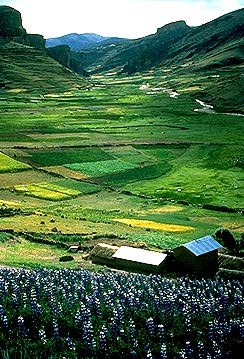
Rotations

The use of rotation should be carefully investigated and utilized in schemes designed to aid traditional farmers, keeping in mind that the value of crop rotation for the management of specific diseases is highly location specific. In addition to agronomic benefits, such as improved soil texture and better use of nutrients and water, rotations contribute to the management of soilborne pathogens. Rotations are probably the best documented traditional disease management practice.
Rotation of crops in a Bolivian mountain valley. Tarwi (purple flower) in the forground is an edible lupine. (Courtesy of Robert W. Hoopes)
More traditional agricultural methods :
| Mulching |
| Slash/Mulch | Frijol Tapado / Web Blight |
| Manipulating Shade | Burning | Flooding |
| Multiple Cropping | Using Organic Amendments |
| Rotations | Fallow | Raised Beds |